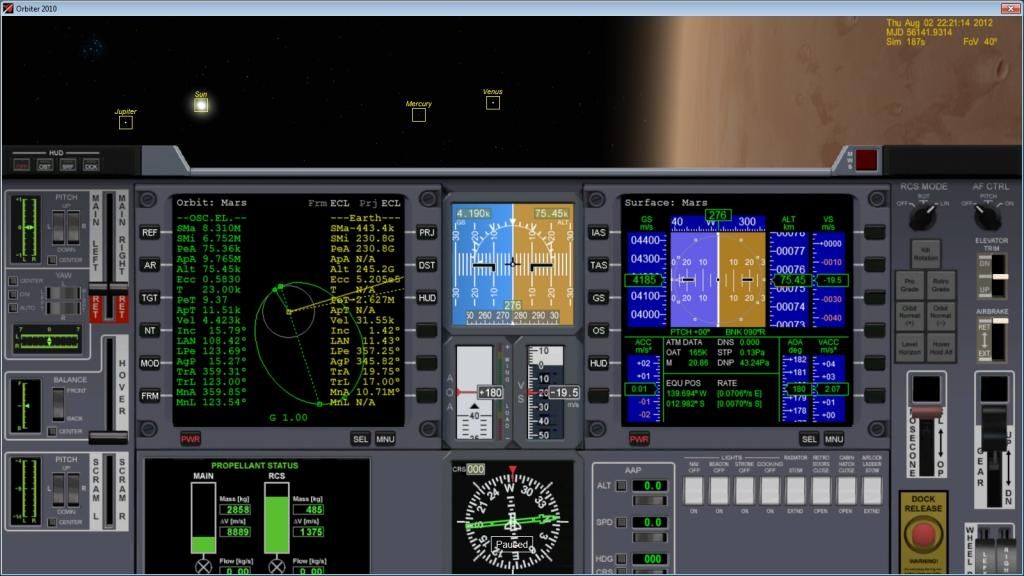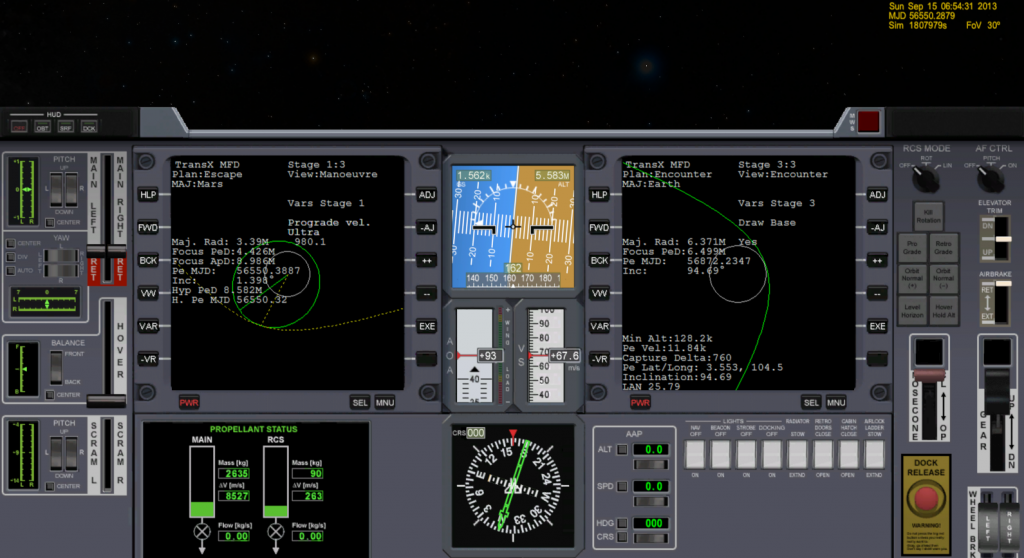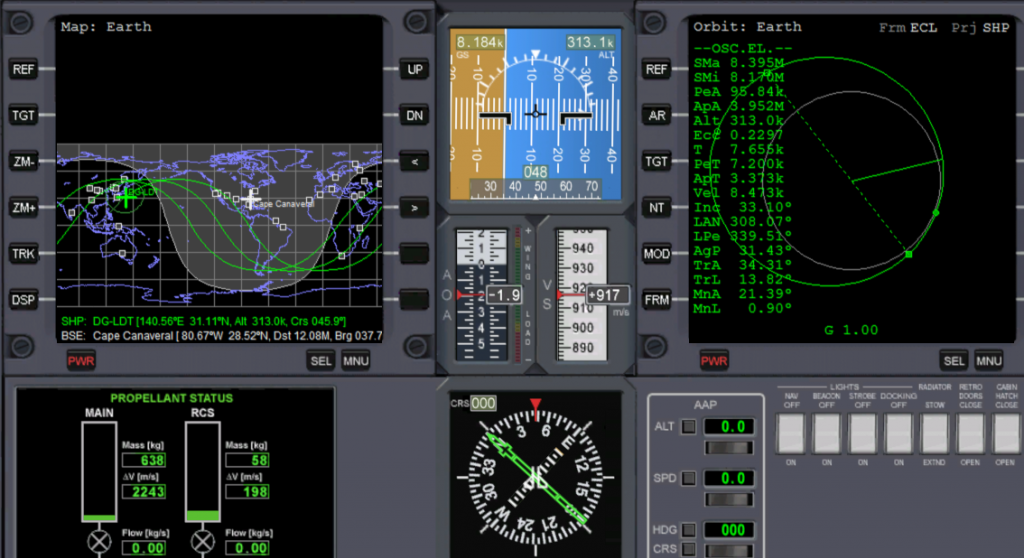- Joined
- Sep 22, 2013
- Messages
- 72
- Reaction score
- 0
- Points
- 0
Mission Control (Orbitnauts) :
LTrotsky (pilot) DG-TROTSKY files, in accordance with the relevant procedures, the Final Pilot Flight Plan.
Mission NASA-STP 002 - Earth/Mars Transit and Return
Leave
2011.9264 12 4 2011
Arrive (Scheduled)
2012.6351 8 19 2012
Flight Plan :
1) D = 12-3-11 0800 local time : Launch using Launch MFD, target Mars
2) D+1 to 24 hours: Use this period to Align and configure TransX staging for transit
3) D+2 to 100 days: Cruise along flight plan
4) D+130 days : Mid Course Correction Burn (MCCB)
5) D+200 days : Final MCCB
6) D+258 days : Target Approach Adjustment Burn (AAB)
7) D+259 to D+260 days : Capture Phase. Enter Mars Orbit, Survey/Video/Photog (Screenshots)
8) D + 261 days : Mission Option. Determine feasibility of Insertion and orbit of 1 Martian moon.
9) D + 263 days : Return Orientation Phase. Begin vessel orientation for Earth Return.
10) D + 264 days : Earth Return Phase Commence. Mars Escape Burn.
11) D + 265 days to ? : Earth Return Cruise, Capture, De-Orbit, Re-entry.
============
Considerations
============
A - Sufficiency of Fuel for items 8 through 11, exclusive of 9, not determined. This is due in part to relative body orientation likely at the time.
B - Comments and Suggestions from Mission Control may be incorporated to FPFP at Pilot discretion.
(I will be getting a new computer, joystick, display, etc, in the next few days so feel free to make suggestions on that score also. Also donating to the site )
)
---------- Post added at 02:47 PM ---------- Previous post was at 02:37 AM ----------
Questions :
1) With a HTO (low energy transfer), it seems that on arrival Mars, the relative positions of Earth and Mars do not permit a time-efficient return. That is, Earth is deflected in it's orbit about 90 degrees prograde from Mars, and it is next to impossible to plot a return without some complicated maneuvers that essentially create a smaller ellipsis around the sun, transit of which permits the Earth to then "catch up" to the vessel, followed by an insertion burn to enlarge the vessel orbit and intercept Earth. Alternatively, one could just do a park orbit round mars and wait for an optimal eject window. Thoughts?
2) Is it possible to orbit the moons of Mars? They are very small.
3) What are some of the flight plans that people use for an efficient (time and fuel) Earth-Mars-Earth circuit?
LTrotsky (pilot) DG-TROTSKY files, in accordance with the relevant procedures, the Final Pilot Flight Plan.
Mission NASA-STP 002 - Earth/Mars Transit and Return
Leave
2011.9264 12 4 2011
Arrive (Scheduled)
2012.6351 8 19 2012
Flight Plan :
1) D = 12-3-11 0800 local time : Launch using Launch MFD, target Mars
2) D+1 to 24 hours: Use this period to Align and configure TransX staging for transit
3) D+2 to 100 days: Cruise along flight plan
4) D+130 days : Mid Course Correction Burn (MCCB)
5) D+200 days : Final MCCB
6) D+258 days : Target Approach Adjustment Burn (AAB)
7) D+259 to D+260 days : Capture Phase. Enter Mars Orbit, Survey/Video/Photog (Screenshots)
8) D + 261 days : Mission Option. Determine feasibility of Insertion and orbit of 1 Martian moon.
9) D + 263 days : Return Orientation Phase. Begin vessel orientation for Earth Return.
10) D + 264 days : Earth Return Phase Commence. Mars Escape Burn.
11) D + 265 days to ? : Earth Return Cruise, Capture, De-Orbit, Re-entry.
============
Considerations
============
A - Sufficiency of Fuel for items 8 through 11, exclusive of 9, not determined. This is due in part to relative body orientation likely at the time.
B - Comments and Suggestions from Mission Control may be incorporated to FPFP at Pilot discretion.

(I will be getting a new computer, joystick, display, etc, in the next few days so feel free to make suggestions on that score also. Also donating to the site
---------- Post added at 02:47 PM ---------- Previous post was at 02:37 AM ----------
Questions :
1) With a HTO (low energy transfer), it seems that on arrival Mars, the relative positions of Earth and Mars do not permit a time-efficient return. That is, Earth is deflected in it's orbit about 90 degrees prograde from Mars, and it is next to impossible to plot a return without some complicated maneuvers that essentially create a smaller ellipsis around the sun, transit of which permits the Earth to then "catch up" to the vessel, followed by an insertion burn to enlarge the vessel orbit and intercept Earth. Alternatively, one could just do a park orbit round mars and wait for an optimal eject window. Thoughts?
2) Is it possible to orbit the moons of Mars? They are very small.
3) What are some of the flight plans that people use for an efficient (time and fuel) Earth-Mars-Earth circuit?
Last edited:



